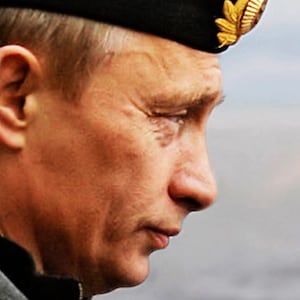MOSCOW—Not much has changed in Russia since Soviet authorities hid the truth about the nuclear catastrophe in Chernobyl more than three decades ago. At the time, Soviet military commanders, KGB generals, and Communist Party leaders were terrified they’d get sacked or end up in the Gulag if the truth came out, so they preferred to lie to the public, delaying the evacuation when radiation equivalent of 500 Hiroshima bombs was released into the atmosphere.
Today, it seems the generals of President Vladimir Putin’s Russia have not learned the dangers of such deceptions: On Thursday the government’s news agency TASS published false reports by the Ministry of Defense about a “normal radioactive level” in the Arkhangelsk region, while Geiger counters indicated a far different picture.
In spite of internet censorship, residents of Nyonoksa, Severodvinsk, and Arkhangelsk near the White Sea in northern Russia received plenty of information from social media–something the victims of Chernobyl did not have.
ADVERTISEMENT
While the official military reports over the last few hours talked about a liquid-fueled rocket catching fire and its engine exploding, independent reports alarmed the public with news of a spike in radiation levels.
“I first learned about the accident from the ‘Mash’ Telegram channel,” says Nadezhda Lyzhnikova, a reporter at the online magazine Ecology of Primorye based in Arkhangelsk. (Last year authorities banned Telegram, an encrypted message service but millions of users continue to use it as an independent source of information.)
The post Lyzhnikova read on Mash said: “There is a proving ground for nuclear powered missiles near Nyonoksa, where the explosion took place, and for nuclear submarines.” Mash also said there were 15 victims and not the eight reported by state controlled media.
Even when 24 hours had passed after the explosion, nobody could give Aleksei Redford, a journalist writing under a pseudonym at the online news outlet STV in Severodvinsk, an adequate explanation on what had exploded in the White Sea on Thursday.
Redford first learned about the increasing radiation from the Center of Public Defense group in his town. “We are asking the military, we are asking the administration where that radiation was from, why it increased for 30 minutes in our town but there is still zero information about the cause,” Redford told The Daily Beast on Friday.
State television was sticking to the official line coming from the Ministry of Defense and did not report on the spike of radiation. Local authorities in Severodvinsk first acknowledged an increase in ambient radiation but then their own press release denied that on Friday.
“The young secretary in the office must have been scared,” Lyzhnikova suggested. Just like bureaucrats in the USSR, Russian officials seem to be more serious about their jobs than about transparency, social awareness and public security.
For a few hours after the accident, millions of Russians saw a map on Channel One as it aired images of the explosion that had allegedly occurred at the Defense Ministry’s base in Nyonoksa by the White Sea. Other Russian media publications speculated about explosions during the tests of the Tsirkon hypersonic cruise missile.
Another Telegram channel, called Baza, said that the Russian military refused to accept the offered help from the Ministry of Emergency Situations and preferred to keep complete control the rescue operation themselves.
The map of Russian military bases is so vast it looks like almost a separate secret state inside the state.
Nyonoksa is a closed military town with a population of fewer than 2,000 people. It is situated less than 40 kilometers away from the city of Severodvinsk. To visit the secret town, one needs to apply for a special pass at least one week before the trip, but there is little chance a random traveler, especially a foreign one, would be allowed to come in.
Severodvinsk, with a population of about 189,000, also is famous for its military industry. But even for residents used to secrecy it was amusing to see the contradictory reports on the state TV channel and then read a press release on the site of the local administration about the radiation spike.
“Putin’s friend Sergei Shoigu, the minister of defense, tests the latest masterpieces in the Arkhangelsk region,” Alexander Golts, a well respected military expert, tells The Daily Beast. Among them is the Burevestnik missile system, which is nuclear powered and supposed to have virtually unlimited range. “So of course it is concerning to see the radiation increase in that particular area,” says Golts.
The NATO designation for the Burevestnik is Skyfall. In March, CNBC cited a U.S. intelligence report that claimed the experimental missile had yet to fly more than 22 miles.
Russian military commanders present the current geopolitical situation as a new Cold War deliberately inspired by United States. The Americans are “seeking a dominant position in everything, including the military domain,” the head of Russian National Security Council, Nikolay Patrushev, told reporters earlier this month.
Patrushev criticized U.S. President Donald Trump for abandoning the intermediate nuclear forces (INF) disarmament treaty, at the same time insisting, “Our newly developed weapons allow us to have a dialogue with the U.S. to argue for the interests that we have.”
In fact many Russians do welcome the army reform and applaud the newly developed weapons shown at military parades on Red Square every year–as long as the breakthrough military experiments do not endanger them or their loved ones.
But when something goes wrong, it’s hard to hide in an era of smartphones and street journalism, when millions of Russians become their own reporters and researchers looking for verifiable facts.
It would have been impossible for the Russian military to keep the explosion of an ammunition depot near Achinsk a secret earlier this week. On Monday, Instagram bloggers posted still pictures and videos of a series of massive blasts that destroyed homes and led to the evacuation of 16,500 people from the area.
But closed military towns are still well sealed and little or no information leaks out. Most probably we are never going to find out what exactly what caused the spike of radiation in Severodvinsk. “The Ministry of Defense has monopolized all the information about the secret tests,” says Golts. “They have not revisited their approach to censorship for years.”
Greenpeace experts asked several Russian ministries and state institutions about a more serious study of the accident in Arkhangelsk region.
“The analyses we see indicates that the situation might have been much more serious, since inhaled radionuclides might continue to damage, so we need more detailed data from the actual area of the accident,” Rashid Alimov, a senior nuclear campaigner with Greenpeace Russia told The Daily Beast.
Although life in Severodvinsk is going back to normal, local people have stocked up on medicine–especially iodine to protect their thyroid glands from radiation–just in case.
“Our reporters have checked: there are no iodine tablets, no potassium iodine left at drug stores in Severodvinsk,” Redford told The Daily Beast. But that’s not all that’s been flying off the shelves. “Red wine and vodka were also in high demand yesterday,” he said. In addition to the usual effects, said Redford, “People believe alcohol helps to scavenge free radicals”–that is, protect cells from damage due to radioactive exposure.
Meanwhile, he said, “Somebody instructed kindergartens to keep all windows and doors shut, which of course would not help against the radiation.”







